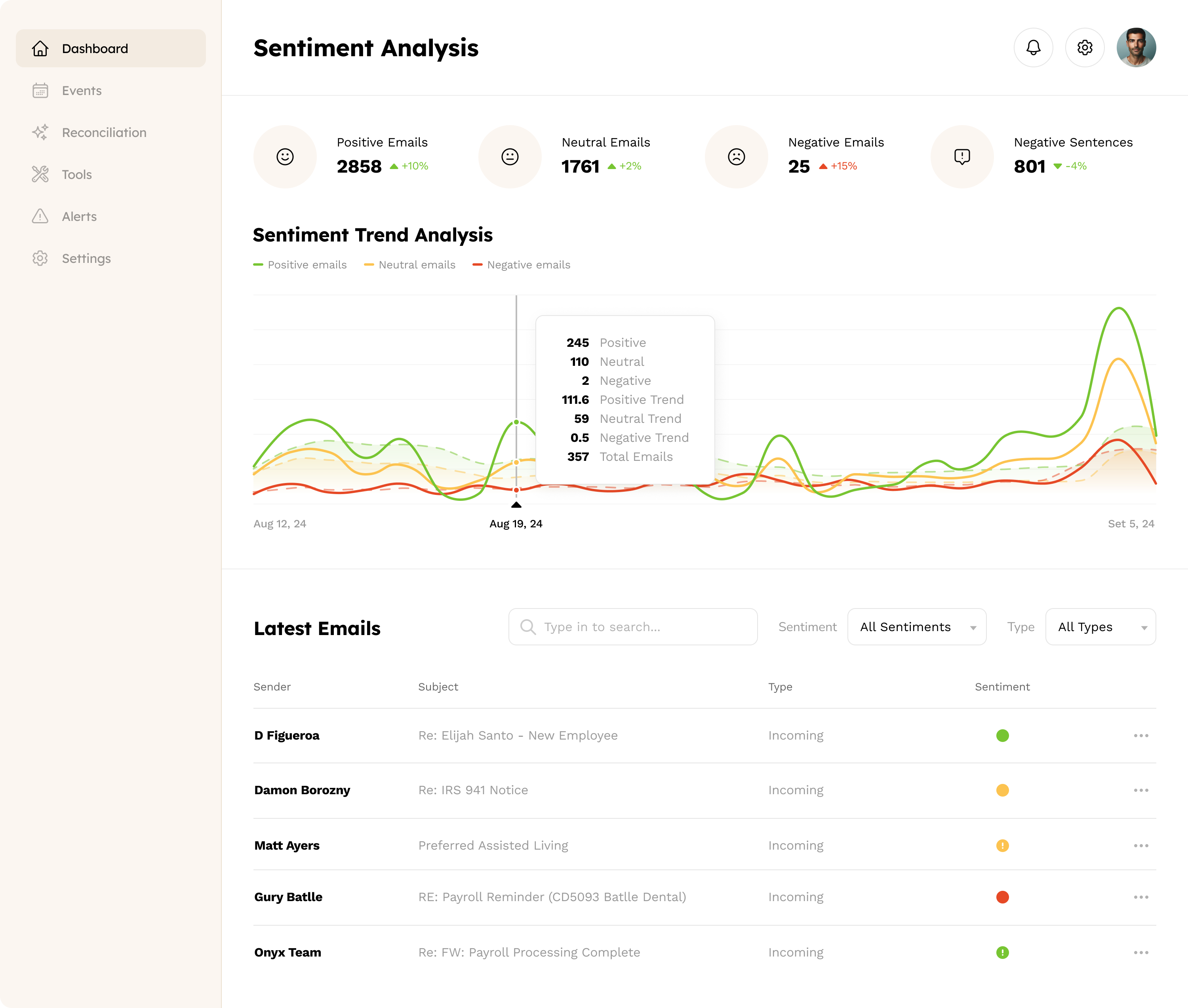Analyse your client relations
.png)

Project Overview
In the competitive landscape of payroll services, customer satisfaction is paramount. Our client recognized the need to maintain strong, positive relationships with their clients by addressing dissatisfaction before it became a serious issue. To help them achieve this, we developed a state-of-the-art sentiment analysis system. This solution could process real-time client communications and provide insights that allowed the company to act on customer feedback before it escalated. This initiative not only improved customer satisfaction but also enhanced the client’s reputation as a proactive service provider.

The Challenge: Navigating Complexity
The key challenge was understanding the nuanced sentiments expressed by customers in their communications. Payroll inquiries can range from routine questions to complex issues that could quickly escalate if not handled properly. Our task was to sift through the noise and pinpoint where customers might be frustrated or dissatisfied. To achieve this, we needed a model that could grasp the specific language used in the industry and detect shifts in sentiment over time.
Furthermore, ensuring the analysis occurred in real-time was crucial. Delays in recognizing negative sentiment could mean the difference between resolving an issue promptly and losing a client. We had to integrate a system that not only analyzed emails as they arrived but also provided easy-to-use tools for the client to understand and act on the data.
The Strategy
Building a Domain-Specific AI Model
Our first step was to create a custom BERT-like AI model, specifically trained on the vocabulary and context of payroll industry communications. We gathered and analyzed thousands of anonymized emails exchanged between the client and their support teams. This process allowed us to fine-tune the model’s understanding of what phrases, words, and expressions might indicate dissatisfaction or frustration.
Real-Time Data Synchronization
We developed a seamless integration with the client’s email system, enabling real-time data sync. The model would continuously analyze incoming emails, evaluating overall sentiment, spotting negative phrases, and keeping a pulse on client satisfaction. This capability allowed the client to monitor changing trends in sentiment throughout the week, providing insights into which days or periods were more stressful for clients.
Visualizing Insights
To make the analysis actionable, we designed a series of interactive dashboards. These dashboards allowed the client to filter data based on various dimensions—like client-specific satisfaction scores, keyword frequency analysis, and temporal trends. We also provided detailed graphs showing sentiment fluctuations, allowing the client to visualize periods of high stress or dissatisfaction.
The Impact
Proactive Client Management
With the sentiment analysis system in place, the client was able to identify at-risk customers and intervene before dissatisfaction turned into churn. Alerts were triggered when a client’s sentiment dropped consistently over a period, allowing support teams to reach out proactively and resolve issues before they escalated.
Insight-Driven Decisions
The insights derived from sentiment analysis went beyond individual interactions. By examining overall satisfaction levels, the client could understand trends across different products, teams, and time periods. For instance, they discovered that certain features led to more customer frustration, allowing them to prioritize improvements that directly impacted satisfaction.
Visualizing Insights
To make the analysis actionable, we designed a series of interactive dashboards. These dashboards allowed the client to filter data based on various dimensions—like client-specific satisfaction scores, keyword frequency analysis, and temporal trends. We also provided detailed graphs showing sentiment fluctuations, allowing the client to visualize periods of high stress or dissatisfaction.
Measurable Improvements
Within six months of deploying the solution, the client observed a 30% reduction in escalated support cases and a notable improvement in their CSAT (Customer Satisfaction Score). By enabling a faster response to emerging issues, they not only retained clients but also improved the quality of their service and were able to train their staff more effectively.
Why it Matters: The Power of Proactive AI
The core of this project wasn’t just about analyzing sentiment; it was about transforming the way the client interacted with their customers. Rather than reacting to issues, they could now anticipate them. This shift in approach had a significant impact on their reputation in the industry, positioning them as a leader in customer-centric service.
From our perspective, this project demonstrated the power of combining industry-specific AI models with real-time data analysis. By tailoring our solution to the unique challenges of the payroll industry, we created a tool that not only met but exceeded the client's expectations, proving that AI can be a game-changer when applied thoughtfully.
Are you ready?
Contact us in your preferred way and let's unleash your full potential.

.png)